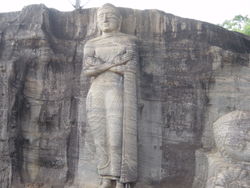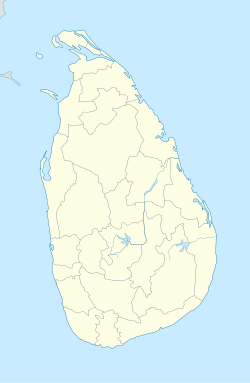Polonnaruwa
| Polonnaruwa | |
|---|---|
 |
|
| Nickname(s): පුලතිසිපුර | |
 Polonnaruwa
|
|
| Coordinates: | |
| Country | Sri Lanka |
| Province | North Central Province, Sri Lanka |
| Polonnaruwa | Before 1070 CE |
| Government | |
| - Mayor | |
| Area | |
| - Total | 3,293 km2 (1,271.4 sq mi) |
| - Land | 3,077 km2 (1,188 sq mi) |
| - Water | 216 km2 (83.4 sq mi) 6.59%% |
| Population (2001) | |
| - Total | 359,000 |
| - Density | 117/km2 (303/sq mi) |
| Time zone | Sri Lanka Standard Time Zone (UTC+5:30) |
| Ancient City of Polonnaruwa* | |
|---|---|
| UNESCO World Heritage Site | |
 |
|
| State Party | |
| Type | Cultural |
| Criteria | i, iii, vi |
| Reference | 201 |
| Region** | Asia-Pacific |
| Inscription history | |
| Inscription | 1982 (6th Session) |
| * Name as inscribed on World Heritage List. ** Region as classified by UNESCO. |
|
The second most ancient of Sri Lanka's kingdoms,(Sinhalese - පොළොන්නරුව, Tamil - பொலனாறு) was first declared the capital city by King Vijayabahu I, who defeated the Chola invaders in 1070 CE to reunite the country once more under a local leader.
Contents |
History
While Vijayabahu's victory and shifting of Kingdoms to the more strategic Polonnaruwa is considered significant, the real Polonnaruwa Hero of the history books is actually his grandson, Parakramabahu I. It was his reign that is considered the Golden Age of Polonnaruwa, when trade and agriculture flourished under the patronage of the King, who was adamant that no drop of water falling from the heavens was to be wasted, and each be used toward the development of the land; hence, irrigation systems far superior to those of the Anuradhapura Age were constructed during Parakramabahu's reign, systems which to this day supply the water necessary for paddy cultivation during the scorching dry season in the east of the country. The greatest of these systems, of course is the Parakrama Samudraya or the Sea of Parakrama, a tank so vast that it is often mistaken for the ocean. It is of such a width that it is impossible to stand upon one shore and view the other side, and it encircles the main city like a ribbon, being both a defensive border against intruders and the lifeline of the people in times of peace. The Kingdom of Polonnaruwa was completely self-sufficient during King Parakramabahu's reign.
However, with the exception of his immediate successor, Nissankamalla I, all other monarchs of Polonnaruwa, were slightly weak-willed and rather prone to picking fights within their own court. They also went on to form more intimiate matrimonial alliances with stronger South Indian Kingdoms, until these matrimonial links superseded the local royal lineage and gave rise to the Kalinga invasion by King Kalinga Magha in 1214 and the eventual passing of power into the hands of a Pandyan King following the Arya Chakrawarthi invasion of Sri Lanka in 1284. The capital was then shifted to Dambadeniya.
The city Polonnaruwa was also called as Jananathamangalam during the short Chola reign.
Present Situation
Today the ancient city of Polonnaruwa remains one of the best planned Archeological relic sites in the country, standing testimony to the discipline and greatness of the Kingdom's first rulers. Its beauty was also used as a backdrop to filmed scenes for the Duran Duran music video Save a Prayer in 1982. The ancient city of Polonnaruwa has been declared a World Heritage site by UNESCO.
Near the ancient city, there is a small town with several hotels (especially for tourists) and some glossy shops, and places to fulfill day to day needs. There are government institutions in a newly built area called “new town,” about 6 km away from the town and the main road. The largest school in the district, Polonnaruwa Royal Central College is situated at new town.
Polonnaruwa is the 2nd largest city in north central province. But it is known as one of the cleaner and more beautiful cities in the country. The greeny environment, amazing ancient constructions, Parakrama Samudraya (a huge lake built in 1200 A.C.), attractive tourist hotels and most importantly nice people with hospitality, always attracted local and foreign tourists. One recent scientific observation is that of its climate changes. Historically Polonnaruwa had a tropical climate most of the year, although it was occasionally chilly in December and January. But in recent years the rain and chillyness has been increased noticeably. Although this is surprising to some people, it is more enjoyable for tourists. But sometimes paddy field farmers suffers when there is too much rain.
Picture Gallery
 Royal palace |
 Lankatilaka temple |
 Thuparama |
 Sandakada Pahana at Polonnaruwa |
 Medirigiriya Vatadage |
 Nissanka Latha Mandapaya at Polonnaruwa |
 Polonnaruwa Vatadage |
 Statue of King Parakramabahu at Polonnaruwa |
 Ruins at Polonnaruwa (i) |
 Ruins at Polonnaruwa (ii) |
 Ruins at Polonnaruwa (iii) |
 Ruins at Polonnaruwa (iv) |
See also
- Anuradhapura
- World Heritage List
- Sigiriya
- Mahawamsa
- Gal Vihare
- Place names in Sri Lanka
Maps
External links
- Discover Sri Lanka - More information & images about Polonnaruwa
- Discover Sri Lanka - Historical background of Polonnaruwa
- Discover Sri Lanka - Old City of Polonnaruwa
- Ancient City of Polonnaruwa
- "Discovering Polonnaruwa" - an article in The Hindu
- Galvihara - a unique display of rock art
- Official website of the Sri Lanka Tourism Board
- A list of traditional names of cities in Sri Lanka
- Places of interest in polonnaruwa
References
- Balasooriya, Jayasinghe (2004). The Glory of Ancient Polonnaruva. Sooriya Printers, Polonnaruva. ISBN 955-8158-01-1 (Archeological ruins)
|
||||||||||
|
|||||||